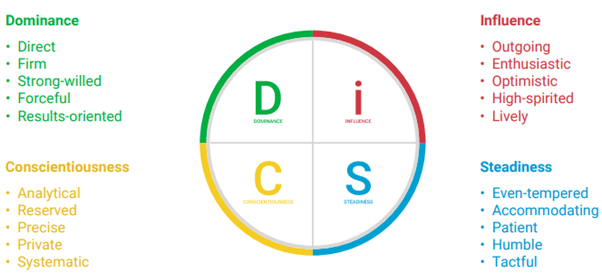The task of creating a direct comparison chart between the 12 Everything DiSC styles and 16 Myers-Briggs Type Indicator (MBTI) personality types becomes problematic because each system assesses unique elements of personality and behavior. The Everything DiSC model assesses workplace behavior with four main styles named Dominance, Influence, Steadiness and Conscientiousness through a circumplex approach resulting in 12 unique styles.

The MBTI method divides personalities into 16 distinct types through four binary dimensions: The four binary dimensions of the MBTI system separate personality types into 16 distinct categories through the dimensions Extraversion vs. Introversion and Sensing vs. Intuition as well as Thinking vs. Feeling and Judging vs. Perceiving. Feeling, and Judging vs. Perceiving. Their shared characteristics prevent direct equivalence so comparisons between them necessitate approximate assessments rather than precise correlations.
The comparison chart below shows how 12 Everything DiSC styles match up to 16 MBTI types based on shared traits and behavioral patterns. The interpretive synthesis lacks a formal one-to-one model comparison since DiSC evaluates outward behavior patterns while MBTI focuses on internal preference scales. This guide provides an initial exploration into how DiSC and MBTI systems might overlap despite their distinct goals because DiSC delivers practical workplace insights and MBTI helps deepen personal self-understanding.
Everything DiSC Styles vs. MBTI Personality Types
| Everything DiSC Style | Key Characteristics | Closest MBTI Types | MBTI Characteristics Alignment |
|---|---|---|---|
| D (Dominance) | Results-oriented, assertive, decisive | ENTJ, ESTJ | Goal-driven, leadership-focused, decisive (Extraverted Thinking, Judging) |
| Di | Dynamic, bold, persuasive | ENTP, ESTP | Energetic, quick to act, influential (Extraverted, Perceiving adaptability) |
| iD | Enthusiastic, action-oriented, outgoing | ESFP, ENFP | Energetic, spontaneous, people-focused (Extraverted, Perceiving enthusiasm) |
| i (Influence) | Sociable, optimistic, collaborative | ENFJ, ESFJ | Warm, relationship-oriented, team-driven (Extraverted Feeling, Judging structure) |
| Everything DiSC Style | Key Characteristics | Closest MBTI Types | MBTI Characteristics Alignment |
|---|
| iS | Cheerful, supportive, empathetic | ENFP, ESFJ | Positive, people-focused, adaptable or structured (Feeling, Extraverted warmth) |
| Si | Accommodating, patient, team-focused | ISFJ, INFP | Supportive, considerate, harmony-seeking (Introverted, Feeling emphasis) |
| S (Steadiness) | Calm, reliable, cooperative | ISFJ, ISTJ | Steady, dependable, process-oriented (Introverted, Sensing stability) |
| SC | Reserved, methodical, consistent | ISTJ, ISFP | Practical, detail-oriented, reserved (Introverted, Sensing or Feeling steadiness) |
| CS | Cautious, precise, reflective | INTP, ISTP | Analytical, careful, independent (Introverted, Thinking or Perceiving precision) |
| C (Conscientiousness) | Analytical, objective, detail-focused | INTJ, ISTJ | Logical, systematic, goal-oriented (Introverted Thinking, Judging structure) |
| CD | Skeptical, determined, questioning | INTJ, INTP | Strategic, critical, independent (Introverted Thinking, analytical depth) |
| DC | Driven, perfectionistic, resolute | ENTJ, ESTJ | Ambitious, structured, results-focused (Extraverted Thinking, Judging determination) |
Everything DiSC Personality Styles Vs Myers-Briggs (MBTI) Personality Types: Key Observations
1. Dominance (D, Di, DC, CD):
- MBTI personality types that display strong Extraverted Thinking (Te) or Introverted Thinking (Ti) characteristics and who focus on results and assertiveness such as ENTJ, ESTJ, and INTJ show alignment.
- The workplace-focused action styles of DiSC (Di and DC) resemble Perceiving types in MBTI (ENTP and ESTP) because of their shared adaptability.
2. Influence (i, iD, iS):
- The MBTI types ENFJ, ESFJ, ENFP, and ESFP show strong Extraverted Feeling (Fe) or Perceiving energy.
- The focus on sociability and enthusiasm connects Extraverted personality with Feeling preferences.
3. Steadiness (S, Si, SC):
- The personality traits of calmness and dependability make these characteristics common among Introverted Sensing Feeler types such as ISFJ and ISTJ.
- Si and SC exhibit cooperative behavior alongside introverted tendencies which mirrors the characteristics of both ISFJ and INFP personality types.
4. Conscientiousness (C, CS, CD):
- The analytical and detail-focused characteristics of certain MBTI types such as INTJ, ISTJ and INTP reveal a connection to Introverted Thinking (Ti) and Judging (J) attributes.
- The Everything DiSC styles of CD and CS demonstrate elements of skepticism alongside precision which are characteristic of INTJ and ISTP MBTI types.
Everything DiSC Personality Styles Vs Myers-Briggs (MBTI) Personality Types: Key Observations, Limitations
- Behavioral vs. Cognitive: DiSC focuses on behavioral patterns particularly in professional environments while MBTI examines cognitive processes and perception. A strategic thinker with INTJ personality type displays “D” behavior when leading people but not during their personal time.
- Granularity: The 12 styles of DiSC mix four basic traits together unlike MBTI’s 16 distinct types which cannot be perfectly matched.
- Context: The DiSC model applies specifically to workplace behaviors while MBTI covers broader personality aspects which leads to alignment based on contextual interpretation.


